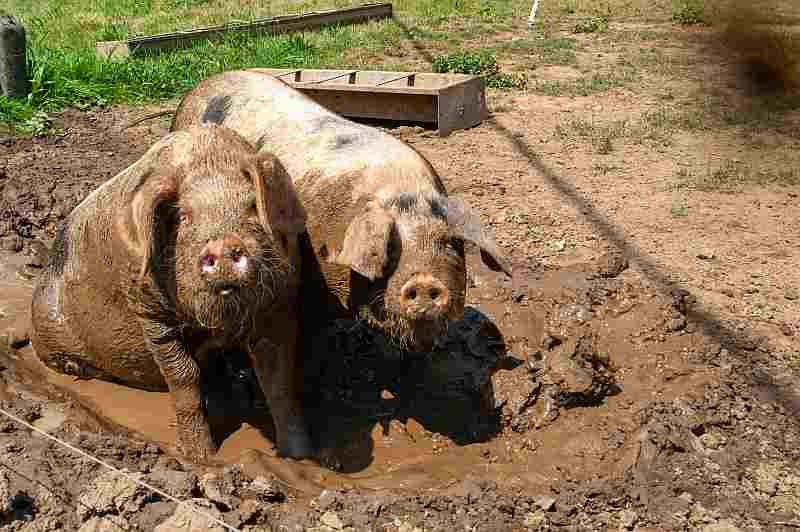Have you ever wondered why do pigs like mud? You’re not alone. It’s a fascinating topic, blending biology, ecology, and animal behavior.
Contrary to popular belief, pigs aren’t just being messy. It’s a natural instinct with surprising health benefits. Dive into the nitty-gritty of why these intelligent creatures love their mud baths, debunk myths, and discover mud’s vital role in pig farming.
It’s more complex and scientific than you’d ever imagine.
Key Takeaways
- Mud is a natural way for pigs to communicate and express dominance or submission.
- Mud plays a vital role in maintaining pigs’ overall health and well-being, keeping their skin hydrated, providing a cooling mechanism, protecting against UV rays, and acting as a natural insect repellent.
- Mud helps pigs regulate their body temperature by drawing out body heat and aiding in cooling.
- Mud is a protective barrier against parasites, reducing their overall load and keeping pigs pest-free.
Understanding Pigs’ Natural Behavior
You’ll find that a significant part of pigs’ natural behavior is their affinity for mud, which serves a few essential purposes.
Firstly, it’s a way for pigs to cool down as they lack sweat glands. It’s also a means of pig communication. Pigs use wallowing in mud to express dominance or submission, contributing to their complex social structure.
Secondly, mud serves as a protective layer against parasites and sunburn, showcasing swine intelligence in self-care. Pigs understand the benefits of mud and seek it out. They’ve been observed creating mud holes and even sharing them. This behavior indicates their cognitive abilities and social dynamics, proving that pigs are far from dirty but rather intelligent and sophisticated.
The Role of Mud in Pigs’ Health
Understanding the role of mud in a pig’s health might surprise you, as it’s more than just a cooling mechanism. Mud baths play a crucial part in maintaining the health of pigs. Being in mud keeps their skin hydrated, which is essential for their well-being.
Pigs lack sweat glands, so they’re prone to overheating. The mud not only cools them down but also provides a protective barrier against the sun’s harmful UV rays. Additionally, it serves as a natural insect repellent, keeping away pesky parasites that could harm them.
Through a scientific lens, you can see that mud isn’t just fun for pigs but a requirement for their health. So, next time you see a pig enjoying a mud bath, remember it’s not just play; it’s essential self-care.
Mud and Pigs’ Body Temperature Control
With a pig’s body temperature control in mind, it’s crucial to note how mud plays a vital role in their cooling process. Unlike humans, pigs don’t have a highly efficient sweating mechanism. They can’t cool down quickly by sweating like we do.
This is where mud and its thermal conductivity come into play. Mud, being a good conductor of heat, draws out the body heat from pigs, helping them maintain a healthy body temperature.
When a pig wallows in mud, the evaporative cooling effect of the drying mud works much like our sweat does. It’s a natural, effective way for pigs to keep cool.
How Mud Protects Against Parasites
Besides keeping cool, there’s another solid reason you’d find pigs enjoying a mud bath: it provides a remarkable defense against parasites.
You may not know it, but mud bathing is a natural parasite repellent. When a pig rolls in the mud, it forms a barrier over its skin. This barrier is inhospitable to many parasites, like lice and ticks, effectively deterring them from making a home on the pig’s body.
The mud also traps these parasites, isolating them from the pig’s skin. When the mud dries and falls off, the parasites go with it, reducing the overall parasite load.
Dispelling Myths About Pigs and Dirt
Now, let’s tackle some widespread myths you might’ve come across about pigs and dirt, building on what we’ve just uncovered about their mud-bathing habits.
Contrary to popular pig stereotypes, pigs aren’t inherently dirty creatures. Swine hygiene is actually quite advanced. Pigs use mud primarily as sunblock and insect repellent, not because they enjoy filth. They’re unable to sweat, and thus, mud acts as a cooling agent on hot days.
Furthermore, you’ll typically find that pigs designate specific areas in their pen for waste, separate from their sleeping and eating areas. This disproves the notion of pigs being ‘dirty animals’ and shows their innate sense of cleanliness.
It’s time we revise our understanding and stereotypes of these intelligent animals.
The Importance of Mud in Pig Farming
Understanding the critical role of mud in pig farming, you’ll realize that it’s not just about keeping pigs cool and pest-free but also about maintaining their overall health and well-being.
Mud composition, rich in essential minerals like iron, is vital in supplementing the pigs’ diet, thus enhancing their health. With strategic farming techniques, you can optimize the mud’s properties for the pigs’ benefit.
For instance, by maintaining the proper moisture level, the mud can form a protective barrier on pigs’ skin, warding off parasites and sunburn. Moreover, mud baths can also serve as a means of natural stress relief, contributing to the overall wellness of the pigs.
Hence, mud isn’t merely a cooling agent but a crucial component in pig farming.
Frequently Asked Questions
What Is the Lifespan of a Pig in a Natural Environment Compared to a Farm Environment?
You’re asking about pig longevity. In nature, pigs’ intelligence helps them dodge predators, living up to 15 years. On farms, they’ve fewer threats but are often slaughtered young, typically living just six months to a year.
Do Pigs Have Sweat Glands and How Do They Work?
Yes, pigs have sweat glands, but they’re not very efficient. That’s why pigs need other methods, like wallowing in mud for cooling down. It’s essential for their gland functionality and overall hydration.
How Does the Skin of Pigs React to Different Weather Conditions?
You’ve asked about pig skin’s reaction to weather changes. Pigs’ skin, lacking pigmentation protection, is sensitive to sunburn. They use mud for heat regulation, cooling their bodies in hot conditions and insulating them in the cold.
What Is the Impact of Mud on the Pigs’ Mental Health and Well-Being?
You’ll find that mud therapy benefits pigs, providing psychological enrichment. It’s akin to a natural stress reliever, enhancing their well-being. So, it’s not just physical comfort; mud also contributes to their mental health.
How Does the Pig’s Diet Affect Its Interaction With Mud?
Your pig’s diet can impact its mud interactions. Certain nutrients may increase mud consumption for mineral absorption. However, monitoring this behavior is crucial to avoid potential health risks from ingesting too much soil.
Conclusion
So, pigs aren’t just rolling in the mud for fun. It’s a natural behavior that helps them stay cool and fight off parasites. Just think about it like their version of sunscreen and bug spray combined.
Even in modern pig farming, the importance of mud can’t be underestimated. So, next time you see a pig in the mud, remember they’re not dirty; they’re just taking care of their health in the most piggy way possible!

